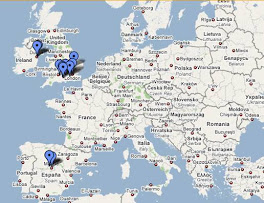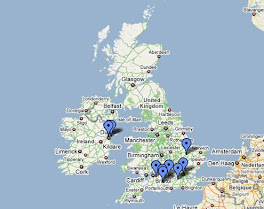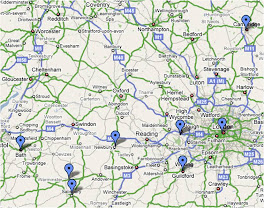Taking the subway back into town, we were hoping to hop around shops in the Marienplatz (the town square) for an hour or so before touring the Residenz Palace. Arriving at the Marienplatz, Bill and I ducked into another bakery to escape the frigid wind until the shops opened at 9:30 a.m. Splitting an apfelschnecken (apple pastry) and sipping fruit tea, we watched light snow flakes begin to fall from the sky. Watching snow fall on a picturesque German city while sitting in the comfort of a small cafe is rather comforting. Therefor, it was no wonder why I was reluctant to leave my hot cup of tea a few minutes later to head back into the cold weather.
Despite snow flurries, the Marienplatz has several cute German shops selling everything from clothing to traditional Christmas decorations. Though a few larger "department-like" stores could be found, most of the shops were small boutiques specializing in a specific genre of goods. My favorite shop was Dallmayr, which specializes in coffees and fine foods. Though rather large compared to many of the stores in the Marienplatz, Dallmayr was fun for browsing through fine wines, handmade German chocolates, and a plethora of spices and ingredients. Splurging a bit on wine and chocolates, I rationalized my purchases with the infamous traveler's quote, "I may only visit here once!"
Lugging our shopping bags back to the hostel and locking our purchases in a secure locker, Bill and I rushed off to the Residenz Palace to view a taste of Bavarian opulence. Built by the Wittelsbach royal family in the 14th century, the Residenz was badly damaged in the first and second World Wars. Practically leveled during World War II, the citizens of Munich rebuilt the Residenz in its original style of fine tapestries and ornate gold leaf walls. By far, the two most magnificent rooms of the palace are the Shell Grotto and the Antiquarium. Demolished by WWII, the Shell Grotto is constructed from thousands of seashells. After the second World War, the people of Munich wanted to rebuild the grotto, but they lacked enough money to undertake such an ambitious project. Persistant to resurrect the ornate monument, the townspeople collected seashells throughout Germany and rebuilt the grotto themselves from pictures taken during the Nazi regime. The Antiquarium, on the other hand, was one of the few rooms in the palace that managed to escape total demolition during the two World Wars. Supported by dozens of stone arches, every ceiling panel and archway is painted with a beautiful Renaissance fresco. Among paintings of angels and saints, scenes from 120 Bavarian towns are depicted on the walls. Aside from the beautiful paintings, the Antiquarium contains rows of Roman emperor busts. By displaying these busts, the Wittlebachs hoped to convince the rest of the world of their ancestral connection to the great ancient Roman emperors.
Loving nearly every moment in the beautifully reconstructed Residenz palace, Bill and I decided to change pace a little and view a darker side of German history -- Dachau Concentration Camp. One of the first German concentration camps built during the Holocaust, Dachau was conveniently located on the outskirts of Munich away from prying eyes of the townspeople. Walking to the train station to catch a ride to the concentration camp, Bill and I ran into an interesting sight not yet experienced in Europe: a public rally. Though I can understand a limited amount of German, I wasn't able to figure out why the protestors were waving a German flag while wrapping themselves in flags representing Turkey. Seeing fully-armed riot police cautiously watching the crowd nearby, Bill and I decided that it would be best to avoid a public protest in a foreign nation that doesn't speak primarily English!
The cold, grey winter weather set the mood for our visit to Dachau. Demolished and leveled after the fall of the Nazi regime, only the walls foundations of camp remain as a cold reminder of the horrors of the Holocaust. The front gate of the camp where prisoners were led into a life of oppression and inhumane living conditions boldly states, "Arbeit Macht Frei," which was the Nazi motto of "Work Makes You Free". To educate visitors that wish to tour the camp, a Holocaust museum was built along the perimeter and two prisoner bunkers were reconstructed in the original design. The museum was unlike many of the museums that Bill and I have toured thus far. While most museums have artifacts and works of art, the Dachau Museum consisted of mainly posters with very few artifacts (which is understandable since most Nazi memorabilia was destroyed after WWII). Most importantly, the museum contains a theater that plays 20-minute documentaries on the Holocaust in several languages. Catching an English showing, Bill and I were appalled by suffering inflicted by the Nazis as part of their "ethnic cleansing" program. I've seen pictures of the Holocaust in many history books, but the video footage shown in the Dachau theater was more vivid than any that I have seen before. Because Dachau was one of the first concentration camps, the Nazis often took pictures and videos of their inhumane practices to use as training aids for other camps. Learning that only 32,000 people were murdered at Dachau (a relatively low number compared to other camps) made me feel sorrow for the pain and suffering experienced by the German nation. To quote my international adviser at Surrey who is from Germany, "Few people realize that the German nation suffered the most during World War II." Seeing evidence of the horrors created by the Holocaust, I understand why the current motto of Dachau Concentration Camp Memorial rings true to all who visit there:
"Never Again."











No comments:
Post a Comment